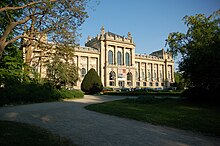Natural History Society of Hanover
The Natural History Society of Hanover (NGH) is a non-profit association based in Hanover , the purpose of which is to promote and disseminate knowledge of nature. The society was founded in 1797 as a reading society , from which the NGH emerged in 1801 with the approval of its statutes. The NGH has 475 members and is today the second oldest scientific society in Germany. It is open to all sections of the population and is not limited to purely academic circles.
activity
Since it was founded, the NGH has adhered to the scheme of the division of the natural world into the three realms "Plants - Animals - Stones", which was established in ancient times when selecting the topics for the monthly lectures . There were also contributions on general natural history, such as anthropology and travelogues. Building on this, botany, zoology and geology still form the three pillars of the NGH today. The purpose of the association has been the promotion and dissemination of knowledge about nature for 212 years. The following topics are dealt with in detail:
- geology
- botany
- zoology
- paleontology
- archeology
- Landscape science
- medicine
- technology
For this purpose, lecture series are organized in the winter half-year with subsequent discussion and around ten excursions that take place every year. In addition, there is the editing and collecting of scientific publications. The annual reports are the scientific mouthpiece of the Natural History Society. The reports are supplemented by supplements, special publications and geological hiking maps. To date, 159 reports (2017) and 14 supplements (up to 2002) as well as some special publications have been published. The most extensive book project to date is a publication about the Deister, which appeared in 2017.
history
The NGH emerged from a reading society founded in 1797 under the chairmanship of Hofmedicus August Ludwig Mensching, in which rare and expensive books were purchased together and were available to members in turn (first purchase 38 folios worth 138 Reichstalers). The first statute ( The Constitution of the Natural History Society of Hanover ) was passed on April 13, 1801 and approved by the Royal Ministry on December 2, 1801. The first internal lecture was given on October 1, 1798, the first public lecture on April 7, 1858.

Print by Julius Giere's lithographic press
From 1821 to 1822 the court medical officer Johann Anton Lammersdorf was the first chairman of the society.
A first educational excursion led to Winzenburg near Alfeld on June 14, 1863 and the first publication (annual report) appeared in 1851 as the annual report of the Association for the Establishment of a Natural History Museum . Especially from the middle of the 19th century, the society started a series of initiatives under its chairman Friedrich Ernst Witte (1853–1866), which had a lasting influence on the development of today's state capital Hanover ( see initiatives ).
The library and archive of the NGH were totally destroyed by incendiary bombs in 1943. At that time the society owned 4,635 individual works and 23,365 volumes of magazines, etc. The valuable collections of the NGH survived the destruction of the Second World War without major damage and still form an essential part of the natural history department of the Lower Saxony State Museum in Hanover.
After the war, a new library was built, which was given as a gift to the library of the Technical University of Hanover (TU) around 1960 ; in the meantime there were around 10,000 items in stock again. Since then, the exchange has been carried out from the university library with around 235 exchange partners in around 128 countries around the world. After the Second World War, the NGH tried over the years to contribute to an intensified discussion of the compatibility of ecology and economy. I.a. Some reports from the last few years dealt with the state of soil, air and water, combined with the effects on animals and plants in the city of Hanover.
Today, after the Society of Friends of Natural Sciences in Berlin, the NGH is the second oldest scientific society in Germany that is accessible to everyone (not a learned society ) and has existed without interruption since its foundation. All other formerly older companies no longer exist or have only resumed their operations after a certain period of dissolution.
Initiatives
Museum of Art and Science
In 1799, 119 pieces of rock and minerals from the Harz were handed over to the NGH during a lecture . With this, the members of the NGH began to collect more. In addition, smaller and larger private collections were donated to the NGH's holdings. In 1849 the King gave the NGH rooms free of charge in the Prinzenhaus am Reitwall so that the library and collection could become the core of a new museum to be built. Together with the Historical Association of Lower Saxony (founded in 1835) and the Association for Public Art Collections (founded in 1848), a public call for an initiative to build a natural history museum in Hanover was launched in 1850. The Museum of Art and Science (now the Künstlerhaus ) was built with financial support from King George V and the City of Hanover and was inaugurated on February 23, 1856.
Founding member of the Lower Saxony State Museum in Hanover
The Welfenhaus and many private individuals donated minerals, fossils , animal preparations and natural history objects of all kinds to the NGH . The collection and exhibition rooms on Sophienstrasse were therefore soon too small for the holdings. Since no structural extensions were possible in 1895, the provincial committee submitted an application for a new building in the front part of the Masch . A new museum building at the Maschpark was planned, and parts of the new building could already be used in 1902. In 1906, the NGH sold its entire collection to the new Provinzialmuseum, as priority was given to scientific work with the material over a mere exhibition. The NGH thus laid the foundations for today's natural history department of the Lower Saxony State Museum in Hanover .
Foundation of the zoological garden
The NGH's suggestion to found a zoological garden met with broad approval in Hanover in the middle of the 19th century. The NGH set up a three-person commission to hold talks with the City of Hanover. On February 25, 1863, there was a general assembly of those interested in the zoo, and in the summer of the same year construction of a zoological garden began. In May 1865 the Hanover Zoological Garden, today Hanover Zoo , was opened. Its board of directors consisted largely of members of the NGH.
Construction of the slaughterhouse in Hanover
As a result of the rural exodus as a result of industrialization from the middle of the 19th century, major hygienic deficits arose in Hanover, which represented a constant threat to people and even the risk of epidemics. Because of the large number of small slaughterhouses spread across the city, the NGH formed a commission to establish a slaughterhouse in December 1865, which initially received little support from the municipal committees. However, the Trichinenschau was introduced on the Hanoverian slaughterhouses that same year. It was not until a trichinae epidemic broke out in Linden in 1874 and the resulting association for the construction of a slaughterhouse in Hanover, brought the magistrate to insight, and the new slaughterhouse was inaugurated on today's Hans-Böckler-Allee in 1881.
Participation in a "Commission for General Health Care"
In 1872, 41 of 45 municipal wells were in poor condition, contaminated with faeces and slaughterhouse waste, and only four were of mediocre quality. In 1873, 60 members of the NGH joined the newly formed "Commission for the Improvement of Public Health Care", which initially had set itself the goal of a healthy water supply for the Hanoverian population. In 1878 a waterworks was put into operation, which initially supplied half of the city's population. From 1890, the city began building a sewer system at great expense . In 1870, at the suggestion of the Hanover Architects and Engineers' Association, a "Commission for General Health Care Measures" was set up to which the NGH sent four members. The NGH was also involved in nutritional issues. The processing and distribution of the milk often resulted in contamination. In 1911, the NGH suggested the construction of cold stores (3 ° –7 ° C) as a solution.
Founding member of the Lower Saxony Heimatbund
In 1905 the Lower Saxony Homeland Association was founded. The NGH was a founding member and is still a member today. In 1934 she joined the “Lower Saxony Associations Office” (later the culture ring) and remained its member until its end in 2000.
Current structure
The first chairman is Dieter Schulz, the second chairman is Klaus D. Jürgens. The statutes also provide for a treasurer and secretary for geosciences, biosciences (botany) and biosciences (zoology) for the board, which is elected for three years. In addition, the board of directors can appoint an advisory board that is appointed for five years and currently consists of nine people. The seat of the company is the Lower Saxony State Museum in Hanover.
literature
- Michael Schmitz (Hrsg.): 200 Years of the Natural History Society of Hanover , booklet to the exhibition "NaturWissen. 200 Years of the Natural History Society of Hanover in the Historical Museum Hanover from November 13, 1997 to February 8, 1998, Hanover: Lower Saxony State Museum, Natural History Department, 1997, ISBN 3-929444-15-1
- Joachim Gersemann (Ed.): 200 Years of the Natural History Society Hanover 1797–1997 (= report of the Natural History Society Hanover , supplement, no. 13), Hanover 2000, DNB 972320512 .
- Joachim Gersemann, Hansjörg Küster : Festschrift for the 210th birthday of the Natural History Society Hanover. The early years of the Natural History Society of Hanover. Self-published, Hanover 2007 ( downloadable as PDF document )
- Franz Rudolf Zankl : Diploma from the Natural History Society in Hanover. In: Hanover Archive . Sheet K 10.
- Hugo Thielen : Natural History Society Hanover. In: Klaus Mlynek, Waldemar R. Röhrbein u. a. (Ed.): Stadtlexikon Hannover . From the beginning to the present. Schlütersche, Hannover 2009, ISBN 978-3-89993-662-9 , p. 463.
- Dieter Schulz: Since 1797 for the benefit of the citizens. The Natural History Society of Hanover. In: Stadtkind hannovermagazin. 6/2015, p. 24.
Web links
Individual evidence
- ↑ Natural History Society Hanover (ed.): The Deister. Nature - man - history. (= Naturhistorica - Reports of the Natural History Society Hanover. Volume 131). zu Klampen Verlag, Springe 2017, ISBN 978-3-86674-545-2 .
- ↑ Dirk Böttcher : Lammersdorf, (1) Johann Anton. In: Hannoversches Biographisches Lexikon . 2002, p. 220. ( online via Google books ).
- ^ Aims and history of the NGH. Homepage.
- ^ History of the Künstlerhaus Hannover. Homepage.
- ↑ Gerda Valentin: NaturWissen - 200 years of natural history society. teNeues Verlag Kempen, Hannover 1997, ISBN 3-929444-15-1 .
- ^ Author collective: Erlebniszoo Hannover. 4th edition. VistaPoint Verlag Cologne 2008, ISBN 978-3-88973-877-6 .
- ↑ Lothar Dittrich, Annelore Rieke-Müller: A garden for people and animals - 125 years Hanover Zoo. Verlagsges. Grütter, 1990, ISBN 3-9801063-2-2 .
- ↑ Naturhistorica, reports of the Natural History Society Hanover. Issue 158/159. 2016/2017, p. 209.




